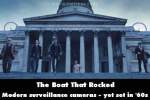
Factual error: In the shot of the front of the National Gallery as the disc jockeys walk down the stairs towards the camera, modern-day surveillance cameras are visible on curved poles to the left and right of the main frontage. (00:52:30)
Factual error: Many of the songs featured in the film, almost all of which are portrayed as being singles actually being played by the disc jockeys, came out after the 1966 setting of the film, including Procol Harum's "A Whiter Shade of Pale" (June 1967), Tommy James and the Shondells' "Crimson and Clover" (November 1968), The Who's "I Can See For Miles" (October 1967), Jimi Hendrix's "The Wind Cried Mary" (May 1967), the Turtles' "Elenore" (November 1968) and Herb Alpert's "This Guy's in Love with You" (April 1968) among several others.
Factual error: Just before Judy in Disguise is played, the DJ starts a record on A and M records. That style of label came out in the mid 1970s.
Factual error: Some E registered vehicles can be seen in this film set in 1966. E registrations weren't issued until January 1st 1967.
Factual error: According to this film the Marine Offences Act came into force on 1st of January 1967 when in fact it came into force on 14th August 1967.






Chosen answer: They can be seen in a couple of long shots of the ship's prow as the DJs shelter there. It's reasonable to assume, given that they were present when the rescue flotilla arrived, that they were picked up as well, just off-screen while the film focused on the main characters.
Tailkinker